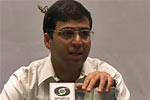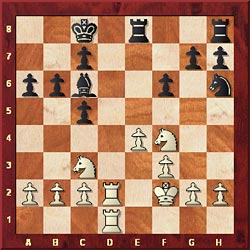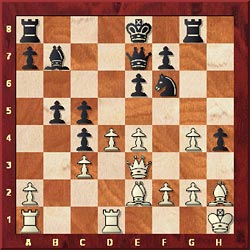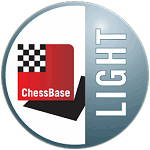


ChessBase 17 - Mega package - Edition 2024
It is the program of choice for anyone who loves the game and wants to know more about it. Start your personal success story with ChessBase and enjoy the game even more.

The World Championship 2007 will take place from September 12 to 30 in the Sheraton Centro Histórico Hotel in Mexico City. Eight players are qualified – the tournament will be a double round robin. The prize fund is US $1.3 million.
Morozevich-Leko ended in a draw after a long but relatively uneventful struggle. Leko missed his chance to complicate the fight by accepting the opponent's piece sacrifice and contented himself with a rather symbolic advantage in a symmetrical position. Anand won a fine positional game against Grischuk. Black tried to solve his problems of coordination by mass simplifications, but White's attack proved strong enough even after that.
In Svidler-Aronian White could not question the reputation of the Exchange Ruy Lopez as a peaceful variation. However, the draw agreement came precisely in the moment when the position became interesting. Kramnik-Gelfand was a complicated game, typical for the Anti-Moscow variation of the Semi-Slav. It is hard to evaluate which of the players was better, but the final part saw Gelfand fighting for a draw, which he achieved.
Morozevich,A (2758) - Leko,P (2751) [C45]
WCh Mexico City MEX (7), 20.09.2007 [Mihail Marin]
1.e4 e5 2.Nf3 Nc6 3.d4 exd4 4.Nxd4 Bc5 5.Be3 Qf6 6.c3 Nge7 7.Bc4 Ne5. Two rounds earlier, facing the same variation against the same opponent, Svidler jumped with his knight only after castling. 8.Bb3 Despite the unsatisfactory result of the aforementioned game, Morozevich sticks to this unusual bishop retreat. 8...Qg6 9.0-0 d5. An accelerated form of central counterplay. The tactical justification consists of the fact that the capture on d5 would lose material to ...Bh3. 10.Bf4 Bg4 11.Qc2 f6 12.Ba4+ c6 13.Nd2 0-0 14.f3 Bd7 15.Kh1 Bb6 16.Rae1 Rae8

We have reached a curious position. The pawn structure is perfectly symmetrical if we take the centre of the board as a reference point. Both sides' development is just normal, which makes the chances about equal. In the next phase of the game, both players will manoeuvre in their own territory, hoping to convince the opponent to release the tension in the centre and this way get some micro-initiative. 17.Re2 Kh8 18.Bg3 Qh5 19.Qd1 Bc7 20.Rfe1 Bb8 21.exd5. Finally! 21...Nxd5 22.Nf1 Nb6 23.Bc2 c5 24.Re4!? Rudolf Spielmann would call this a passive sacrifice, because Black is not forced to accept it.

24...Qf7. But maybe in this case he should accept it! After 24...cxd4!? 25.Rh4 Qf7 26.Bxh7 g5 27.Bg6+ gxh4 28.Bxf7 Rxf7 Black would get more than sufficient material compensation for the sacrificed queen, while the weakness of his king is not easy to take advantage of. 25.Nb3 Bf5 26.R4e2 Rd8 27.Rd2 Bxc2 28.Qxc2 Rxd2 29.Nfxd2 c4 30.Nd4 Nbd7 31.Re2 a6 32.Ne4 b5 33.b4 Qd5 34.Nf2 Nb6 35.Re4 Qd7 36.Bxe5 Bxe5 37.Ng4 Bb8 38.Ne3 Re8 39.g3 g6 40.Kg2 f5 41.Rxe8+ Qxe8 42.Qd2 Be5 43.Ne2 Kg7 44.Kf2 Qe7 45.f4 Bf6 46.g4 fxg4 47.Nxg4 Qd8 48.Qe3 Nd5 49.Qa7+ Qe7 50.Qxa6 Qd7 51.Nxf6 Nxf6 52.Qa8 Qh3 53.Ke1 Qd3 54.Qa7+ Kh6 55.Qd4 Qb1+ 56.Kf2 Ng4+ 57.Kg3 Qxa2 58.h3 Qxe2 59.hxg4 Qe1+ 60.Kf3 Qh1+ 1/2-1/2. [Click to replay]
Anand,V (2792) - Grischuk,A (2726) [C88]
WCh Mexico City MEX (7), 20.09.2007 [Mihail Marin]
1.e4 e5 2.Nf3 Nc6 3.Bb5 a6 4.Ba4 Nf6 5.0-0 Be7 6.Re1 b5 7.Bb3 0-0 8.a4. Two rounds earlier, Anand broke Svidler's defence in the Marshall... Attack by seemingly simple means. Now, he wisely avoids his opponent's specific preparation, at the same time proving that there is some life left in the Anti Marshall systems, too. 8...b4 9.d3 d6 10.Nbd2 Na5 11.Ba2 c5 12.c3 Nc6 13.d4 bxc3 14.bxc3 exd4 15.cxd4 Nb4



Black only needs two tempi (...Bxa4-b5) in order to obtain a playable position... 34.h5!! [A fantastic move. All White's pieces (with the exception of the e1-rook) were placed on optimal squares already, but the attack did not seem strong enough yet. For instance, after the immediate 34.Ref1 Bxa4 35.Rxf6 Bb5 the situation is not entirely clear. The intervention of the modest h-pawn radically inclines the balance to White's favour.] 34...Bxa4 [If Black blocks the h-pawn with 34...h6 , the weakness of the g6-square would make itself felt after 35.Ref1 Bxa4 36.Rxf6 Bb5 37.Rg6+ with decisive attack.] 35.h6+ Kxh6 36.Rxf6+ Kg7 37.g5 The d6-pawn will perish soon and with it - any hope of saving the game. 37...Rf8 38.Rxd6 Bc2 39.Ne5 Rf4 40.Rf6 Rh4 41.d6 Bxb1 42.Rxb1 Rxe4 43.Rf7+ Kg8 44.Re7 Rd8 45.Rd1 c4 46.d7 Rf4 47.Rf1 Rff8 48.Rxf8+ Kxf8 49.Rxh7 c3 50.Ng6+ 1-0. [Click to replay]
Svidler,P (2735) - Aronian,L (2750) [C69]
WCh Mexico City MEX (7), 20.09.2007 [Mihail Marin]
1.e4 e5 2.Nf3 Nc6 3.Bb5 a6 4.Bxc6 An early deviation from the Marshall Attack. 4...dxc6 5.0-0 f6 6.d4 exd4 7.Nxd4 c5 8.Ne2 Qxd1 9.Rxd1 Bd7 10.Nbc3 0-0-0 11.Be3 Re8 12.Rd2 Bc6 13.Rad1 b6 14.f3 Bd6 15.Bf4 Bxf4 16.Nxf4 Nh6 17.Kf2

Both sides have developed in harmonious way. White's advantage is more of optical nature. His domination along the d-file is rather sterile, while the kingside majority is not easy to promote, being submitted to strong pressure by the enemy bishop. On the other wing, Black's structure is rock solid and provides him with outposts for his pieces (c6, d4). 17...f5 18.exf5 Nxf5 19.Re1 Rxe1 20.Kxe1 g5. The position can be evaluated as roughtly equal, but remains quite interesting. From the spectator's point of view, the abrupt end is slightly frustrating. 1/2-1/2. [Click to replay]
Kramnik,V (2769) - Gelfand,B (2733) [D43]
WCh Mexico City MEX (7), 20.09.2007 [Mihail Marin]
1.d4 d5 2.c4 c6 No Catalan for Kramnik today! 3.Nf3 Nf6 4.Nc3 e6 5.Bg5. Earlier this year, against the same opponent, Kramnik preferred 5.e3 . Remarkably enoguh, play transposed to a Catalan type of position anyway after rather unusual play: 5...Nbd7 6.Qc2 Bd6 7.e4 Nxe4 8.Nxe4 dxe4 9.Qxe4 c5 10.Bg5 Be7 11.Bxe7 Qa5+ 12.Ke2 Kxe7 13.g3 (Better later than never! The bishop finally emerges on the long diagonal!) 13...cxd4 14.Bg2 Nf6 15.Qxd4 Rd8 16.Qf4 Bd7 17.Ne5 and White managed to convert his minimal advantage into a victory in Kramnik-Gelfand, Dortmund 2007. 5...h6 6.Bh4 More ambitious than the capture on f6, as played by Kramnik in the first round. 6...dxc4 7.e4 g5 8.Bg3 b5 9.Be2 Bb7 10.0-0 Nbd7 11.Ne5 h5 12.Nxd7 Qxd7 13.Qc1 In the previous games from this World Championhsip where this variation was played, White preferred to block the kingside with h4. It seems that Kramnik has his own views about it... 13...Rg8 14.Rd1 Bb4 15.Qe3 Qe7 16.h3 h4 17.Bh2 Bxc3 18.bxc3 g4. The logical reaction to White's kingside policy. Black threatens to take over the initiative. The immediate threat is gxh3, when the e4-pawn would be hanging. 19.Kh1. The decision to place the king on a square situated on the same diagonal with the enemy bishop looks at least risky. Safer would have been 19.hxg4 Nxg4 20.Bxg4 Rxg4 21.f3 , when the better structure, the more active bishop and the safer king's position would offer White excellent compensation for the pawn. 19...c5 20.hxg4



 |
|